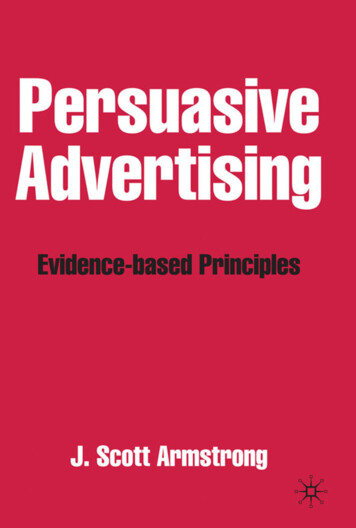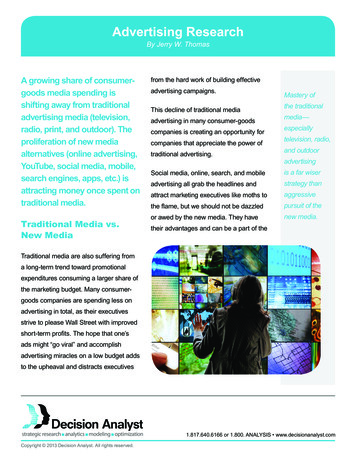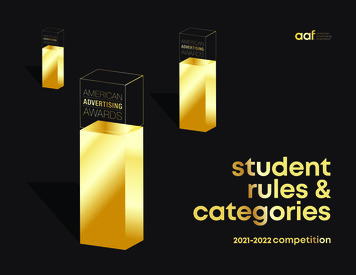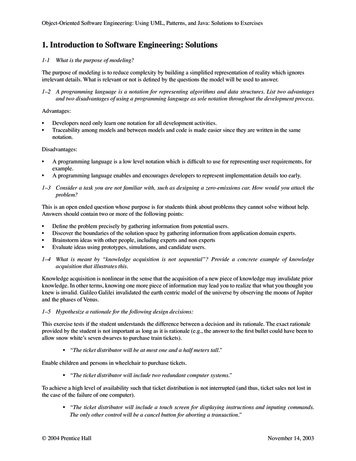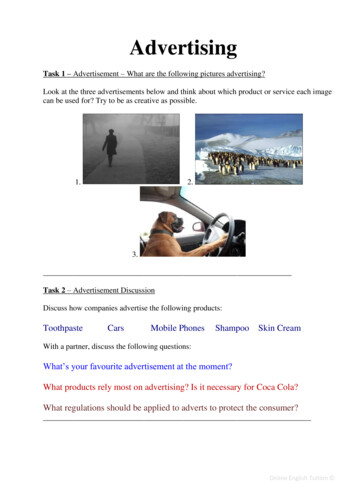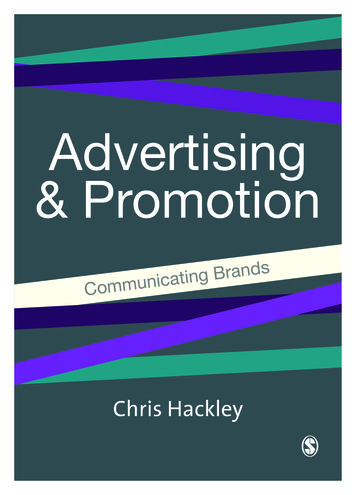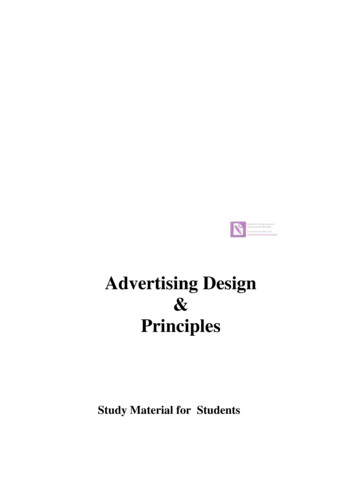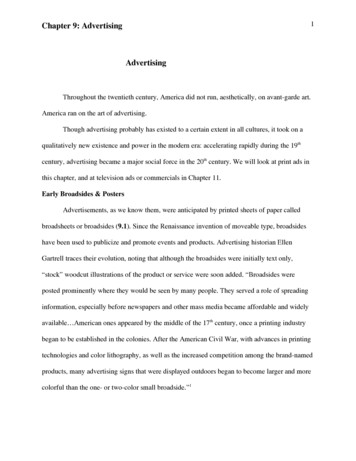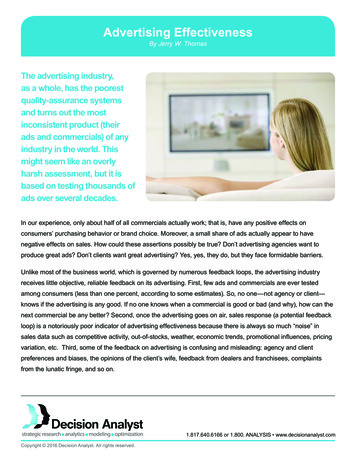
Transcription
Advertising EffectivenessBy Jerry W. ThomasThe advertising industry,as a whole, has the poorestquality-assurance systemsand turns out the mostinconsistent product (theirads and commercials) of anyindustry in the world. Thismight seem like an overlyharsh assessment, but it isbased on testing thousands ofads over several decades.In our experience, only about half of all commercials actually work; that is, have any positive effects onconsumers’ purchasing behavior or brand choice. Moreover, a small share of ads actually appear to havenegative effects on sales. How could these assertions possibly be true? Don’t advertising agencies want toproduce great ads? Don’t clients want great advertising? Yes, yes, they do, but they face formidable barriers.Unlike most of the business world, which is governed by numerous feedback loops, the advertising industryreceives little objective, reliable feedback on its advertising. First, few ads and commercials are ever testedamong consumers (less than one percent, according to some estimates). So, no one—not agency or client—knows if the advertising is any good. If no one knows when a commercial is good or bad (and why), how can thenext commercial be any better? Second, once the advertising goes on air, sales response (a potential feedbackloop) is a notoriously poor indicator of advertising effectiveness because there is always so much “noise” insales data such as competitive activity, out-of-stocks, weather, economic trends, promotional influences, pricingvariation, etc. Third, some of the feedback on advertising is confusing and misleading: agency and clientpreferences and biases, the opinions of the client’s wife, feedback from dealers and franchisees, complaintsfrom the lunatic fringe, and so on.1.817.640.6166 or 1.800. ANALYSIS www.decisionanalyst.comCopyright 2016 Decision Analyst. All rights reserved.
Barriers to Great AdvertisingSome advertisingworks in a fewweeks, whileother advertisingmight take manymonths to showpositive effects,and this delayedresponse canconfound ourefforts to readthe sales data.they are almost always wrong. In ourAdvertising testing could provide aexperience, advertising agencies andreliable feedback loop and lead to muchtheir clients are just as inept at judgingbetter advertising, but many obstaclesadvertising as we are. It seems that nonestand in the way. The first great barrierof us is smart enough to see advertisingto better advertising is self-delusion.through the eyes of the target audience,Most of us believe, in our heart of hearts,based purely on our own judgment.that we know what good advertising isand that there is no need for any kindof independent, objective evaluation.Agencies and clients alike often thinkthat they know how to create and judgegood advertising. Besides, once agenciesand clients start to fall in love with thenew creative, they quickly lose interestin any objective evaluation. No need foradvertising testing. Case closed.A second barrier to better advertisingis the belief that sales performance willreveal if the advertising is working. Unlessthe sales response to the advertising isimmediate and overwhelming, it is almostimpossible to use sales data to judge theeffectiveness of the advertising. So manyvariables are beyond our control, as notedpreviously, that it’s impossible to isolatethe effects of media advertising alone.Strangely, after 40 years of testingMoreover, some advertising works in a fewadvertising, we cannot tell you if aweeks, while other advertising might takecommercial is effective or not just bymany months to show positive effects,viewing it. Sure we have opinions, butand this delayed response can confoundour efforts to read the sales data. Also,advertising often has short-term effectsthat sales data might reflect, and longterm effects that most of us might easilyoverlook in subsequent sales data.Because of these limitations, sales datatend to be confusing and unreliable asindicators of advertising effectiveness.Sophisticated marketing mix modelingis one way to measure these advertisingeffects on sales, but it often takesmillions of dollars and years of effort,2Decision Analyst: Advertising EffectivenessCopyright 2016 Decision Analyst. All rights reserved.
and it requires the building of pristinedatabases of sales information alongwith all of the marketing-input variables.Few companies have the budget, thepatience, the accurate databases, andthe technical knowledge necessary tosucceed at marketing mix modeling. Evenso, marketing mix modeling does not helpus evaluate the contribution of a singlecommercial, but rather the cumulativeeffects of many different commercialsover a long period of time. Also, marketingmix modeling does not tell us why theadvertising worked, or why it failed towork. Was it the message, the mediaweight, or the media mix that made theadvertising effective? Generally, marketingmix modeling cannot answer these typesof questions. So, again, sales data isof limited value when you make criticaldecisions about your advertising.A third barrier to better advertising is apervasive tendency of many (but not all)advertising agencies to delay, undermine,and thwart efforts to objectively test theircreative “babies.” Who wants a reportcard on the quality of their work? It’svery threatening. The results can upsetthe creative folks. The results can upsetclients. The agency can lose control.Agencies can be quite creative in comingup with reasons to avoid copy testing.Copyright 2016 Decision Analyst. All rights reserved.Some of our favorites: There’s no time. We have to be on airin five days, so we’ll just have to skipthe testing. These ads are built on emotion andfeelings, and you can’t measure suchdelicate, artful subtleties. We already tested the ads with a focusgroup during the development process. These are image ads, and you can’ttest imagery with standard advertisingtesting techniques.Marketing mixmodeling doesnot help usevaluate thecontributionof a singlecommercial,but rather thecumulativeeffects ofmany differentcommercialsover a longperiod of time. We have so much equity in thiscampaign that it doesn’t matter whatthe testing results are. We can’t affordto change. We’re in favor of testing, but let’sremove those questions aboutpurchase intent and persuasion fromthe questionnaire.Decision Analyst: Advertising Effectiveness3
advertising. Research firm egos are yetanother problem. Big egos create barriersbecause emotion is driving advertisingdecision-making instead of logic, reason,and consumer feedback. Big egos lead tobad advertising.A fifth barrier to better advertising isthe widespread belief that one’s majorcompetitors know what they are doing.Just copy the advertising approaches ofthe competition and success will surelyfollow. We recently had a client who wasGreat advertisingtends to evolveover time, withlots of hard work,fine-tuning, andtinkering, basedon objectivefeedbackfrom targetconsumers. We are in a new age, with new mediaand new messages, and none of theold copy-testing measures applyany more.of a major competitor, but we were ableto persuade the client to test all majorcompetitive commercials as a precautionbefore blindly copying the competitor’sThe fourth barrier to more effectiveadvertising approach. This competitoradvertising is the big creative ego. Thewas the industry leader in market sharebelief that only the “creatives” in theand profitability. Our testing quicklyagency can create advertising—and therevealed that this industry leader wasconviction that creativity is their exclusivethe industry leader in spite of its baddomain—constitute a major barrier. Greatadvertising. The testing also revealedadvertising tends to evolve over time,that another competitor, in contrast, hadwith lots of hard work, fine-tuning, andgreat advertising. Needless to say, thetinkering, based on objective feedbackclient’s desire to copy the industry leaderfrom target consumers. Big creativequickly vanished.egos tend to resist such evolutionaryimprovements. We have seen greatcampaigns abandoned because agencieswould not accept minor tweaks to theadvertising. To be fair, big egos arenot limited to advertising agencies. Bigclient egos can also be a barrier to good4about to copy the advertising strategyDecision Analyst: Advertising EffectivenessThe sixth barrier to better advertising islack of strategy, or having a poor strategy.The client is most often at fault here. Theclient has not done his homework, hasnot thought deeply about his brand andits future, and has not developed andCopyright 2016 Decision Analyst. All rights reserved.
tested strategy alternatives. The clientwhich was more important—persuasiontells the agency to go forth and createmeasures or recall measures? The truthgreat advertising, without providing anyis that both are important, but of greaterstrategy guidelines. The agency is left toimportance is the fact that neither ofguess and speculate about strategy. Greatthese measures alone, or in combination,advertising is rarely created in a strategymeasures advertising effectiveness. Tovacuum. If the client cannot define ajudge the effectiveness of an ad, manysound strategy, the agency cannot createdifferent variables must be measured andgreat advertising. Again, the responsibilityconsidered simultaneously.for strategy falls squarely on the client.A seventh barrier to better advertising isclient ineptness. Some clients’ processes,policies, and people tend to discourage thecreation of great advertising. Arrogance,ambiguity, impatience, ignorance, riskaversion, and inconsistency tend to be theCreating Better AdvertisingGiven all of these barriers to betteradvertising, how can a client, agency, andresearch company work together to createmore effective advertising?1. The client must craft a soundhallmarks of these “agency killer” clients.strategy for its brand, based onBad clients rarely stimulate or toleratefacts, not wishful thinking andgreat advertising.self-delusion. The client mustThe eighth and last barrier to betteradvertising is poor copy testing byTo judge theeffectivenessof an ad,many differentvariables mustbe measuredand consideredsimultaneously.carefully define the role of advertisingin the marketing plan and set preciseresearch companies. Many advertisingtesting systems are limited to a fewmarkets (and therefore cannot providerepresentative samples). Some systemsare so expensive that the cost of testingexceeds the value of the results. Researchcompanies have been guilty of relyingon one or two simplistic measures ofadvertising effectiveness, while completelyignoring many other very importantvariables. For instance, for several yearsresearch companies argued publicly overCopyright 2016 Decision Analyst. All rights reserved.Decision Analyst: Advertising Effectiveness5
Once strategyand positioningalternativesare identifiedand tested,the strategyshould be lockeddown—andrarely changedthereafter.communication objectives for thetested, the more likely it is that greatadvertising. What exactly does theadvertising will emerge. Testing theclient want the advertising to convey,creative provides a reliable feedbackto accomplish? Agencies are tooloop that helps agency and client alikeoften asked to create advertising in anbecome smarter over time. Once ainformational vacuum. Agencies areconceptual family of commercials isnot miracle workers. Once strategyidentified as the optimal campaign ofand positioning alternatives arethe future, then the campaign shouldidentified and tested, the strategybe locked down. Long-term continuityshould be locked down—and rarelyof an advertising message is essentialchanged thereafter.to maximizing effectiveness.2. As creative executions are3. Use the same testing systemdeveloped against the strategy,consistently. There is no perfecteach execution should be pretestedadvertising testing system. Some areamong members of the targetbetter than others, but any systemaudience. (“Pretesting” refers to testingwill help improve your advertising.advertising before it is aired and/The secret is to use one system overor before final production. When theand over, so that everyone (client,term “testing” is used in this article, itagency, and researchers) learns howis a shorthand term for “pretesting.”)to interpret the testing results for theThe greater the number of executionscategory and the specific brand.4. If budget permits, test theadvertising at an early stage in thecreative process (i.e., the “storyboard”or “animatic” stage) and also test atthe finished commercial stage. Earlystage testing allows rough commercialsto be tweaked and fine-tuned beforeyou spend the big dollars on finalproduction. Early-stage testing tendsto be highly predictive of finishedcommercial scores, but not always.Testing the finished commercials6Decision Analyst: Advertising EffectivenessCopyright 2016 Decision Analyst. All rights reserved.
gives you extra assurance that youradvertising is “on strategy” and working.5. Build your own “action standards”over time. As you test every execution,you will begin to learn what works andwhat doesn’t work. Think of the testingcompany’s norms as very crude, roughindicators to help you get started witha testing program. But, as quickly aspossible, develop your own norms foryour category and your brand (yes,all of the advertising effectivenessmeasures vary by product categoryand brand). Long-term, what you aresearching for are not norms, but actionstandards (that is, the knowledge thatcertain advertising testing scores willtranslate into actual sales increases).6. Use a mathematical model to derive7. Use the testing results as a guideor as an indicator, but do notbecome a slave to the mathematicalmodel. Read all of the open-endedquestions carefully. Make sure youreally understand the underlyingreasons. Base your decisions onan overall score for each execution.this comprehensive assessment ofIt doesn’t matter that an ad has greatthe results, and leave yourself somepersuasion if it does not register thewiggle room. No model or system canbrand name. It doesn’t matter thatanticipate every marketing situationan ad registers the brand name if noor give a 100% perfect solution everyone will notice the commercial itself.time. Informed human judgmentIt doesn’t matter that an ad increasesremains important.short-term purchase interest if it willdamage the brand’s quality reputationover time. So all of the key variablesmust be put together intelligently tocome up with a composite or overallmeasure of advertising effectiveness.Clients andagencies needto accept that“continuousimprovement” ofthe advertisingis an importantgoal8. Clients and agencies need to acceptthat “continuous improvement” ofthe advertising is an important goal.This means that every execution istested and tweaked based on scientificevidence from the target audience.We are not talking about changing theCopyright 2016 Decision Analyst. All rights reserved.Decision Analyst: Advertising Effectiveness7
strategy or changing the campaign, but makingsure that every execution is “on strategy” andworking as hard as possible.9. The ultimate goal of testing is an advertisingsuccess formula that works. That is, the goalof advertising creative development, and the goalof advertising testing, is to identify the elements/ideas essential to advertising effectiveness,and then to make sure that those elements/ideas are consistently communicated by allcredibility, etc.) and long-term power (conveyingadvertising executions.brand image, attaching emotional values to the brand,The Power of AdvertisingWe believe in the power of advertising, based onthousands of studies in our archives. Advertisinghas the power to persuade, the power to influencethe mind, and the power to shape destiny. It hasthe power to change markets and improve profitmargins. Advertising has short-term power (conveyingnew information, building awareness, enhancingbuilding positive reputation, etc.). The great powerof advertising is seldom achieved in practice, butwe can’t give up. The potential and the promise aretoo great. The companies that master the creativeguidance and the testing systems to consistentlydevelop and deploy great advertising will ownthe future and the fortunes that go with it. Greatadvertising is a cloak of invincibility.About the AuthorJerry W. Thomas is the President/CEO of Decision Analyst. He may be reached by email atjthomas@decisionanalyst.com or by phone at 1-800-262-5974 or 1-817-640-6166.Decision Analyst is a global marketing research and analytical consulting firm. The companyspecializes in advertising testing, strategy research, new products research, and advanced modelingfor marketing-decision optimization.604 Avenue H East Arlington, TX 76011-3100, USA1.817.640.6166 or 1.800. ANALYSIS www.decisionanalyst.com8Decision Analyst: Advertising EffectivenessCopyright 2016 Decision Analyst. All rights reserved.
Decision Analyst: Advertising Effectiveness 5 tested strategy alternatives. The client tells the agency to go forth and create great advertising, without providing any strategy guidelines. The agency is left to guess and speculat

